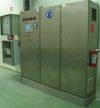

Fire De Tec detects and suppresses fire in an instant.
Fire detection and suppression has come a long way since development as an automated way to detect and put out fires before they spread to unmanageable proportions. The lag time between a fire starting, its detection by smoke or heat detection, and the deployment of a suitable suppressant can differ greatly, and will mean the difference between a successful extinguishment or not.
Fire detection usually starts with smoke detection because where there is smoke there is fire. Sophisticated equipment that needs electrical power uses ionisation to detect particles of smoke that closes a circuit and sets off the alarm or suppression system. Alternatively there is the optical detection method that uses photovoltaic effect to detect differences in the frequencies of light. Both of these methods would require a lag time to detect smoke that emanates from the source fire.
A group of veteran fire equipment design engineers in the USA have developed a system that is foolproof, cost effective and stops fires almost as soon as they start.
The fire suppression industry veterans saw the value in creating fire suppression systems for microenvironments. This concept is simply providing supplemental protection that suppresses fire quickly within the protected space before larger room or building systems would activate.
Fire De Tec is both a detection and suppression system in one. It consists of polymer tubing that ruptures when exposed to flame. The Fire De Tec tubing combines leak resistance, flexibility, durability and precise heat sensitivity causing valves in the tube to open automatically and extinguish the flames in situ where the fire starts. It does not require expensive control panels, or electrical connections, and is the most cost effective automatic fire suppression available. It is a simple design that can be installed by anyone in a short space of time and can be matched with any fire suppression agent such as foam and dry chemical.
The Fire De Tec system is commonly used in enclosures such as electrical boxes, engine compartments, server rooms, industrial machines and other difficult and hard to reach areas where fires could start. The system is even used in wind turbines, but can just as easily be used in the domestic environment where home appliances such as washing machines and clothes dryers often fail and catch alight.
There are two configurations being the direct release low pressure system which utilises Fire De Tec as both the detection and suppression system or the indirect release where the tube is used as only the detection device, but is linked via a Coedeux valve to other tubing which delivers the extinguishing agent from strategically placed nozzles within the enclosure. High pressure suppressants can also be used such as carbon dioxide or argon.
For more information contact SafeQuip, 086 000 FIRE, www.SafeQuip.co.za
© Technews Publishing (Pty) Ltd. | All Rights Reserved.